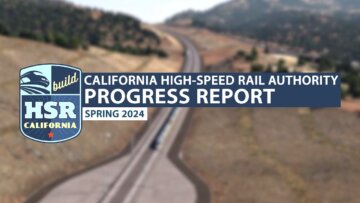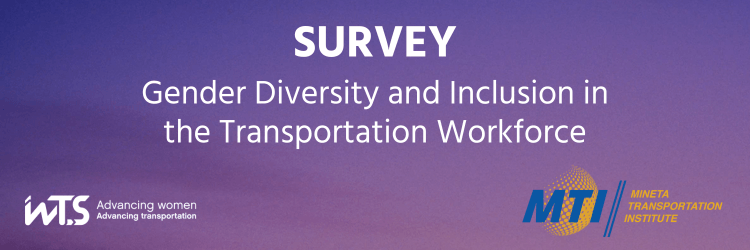|
Statewide News |
Northern California |
Southern California |
Upcoming Events |
High-Speed Rail Takes National Focus
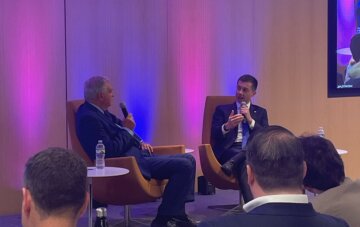 During Infrastructure Week in May, we attended the annual U.S. High-Speed Rail conference, held in Washington, DC, as the nation’s top transportation authorities talked about the future of high-speed rail. Speakers like U.S. Transportation Secretary Pete Buttigieg, Speaker Emerita Nancy Pelosi, and Federal Railroad Administrator Amit Bose discussed progress and milestones on our high-speed rail project, along with Brightline West and Amtrak’s plans for higher-speed rail. We participated on three panel discussions sharing the efforts in developing a diverse, well-trained, skilled workforce prepared to enter the many fields of transportation including design, planning, construction, and operations.=
During Infrastructure Week in May, we attended the annual U.S. High-Speed Rail conference, held in Washington, DC, as the nation’s top transportation authorities talked about the future of high-speed rail. Speakers like U.S. Transportation Secretary Pete Buttigieg, Speaker Emerita Nancy Pelosi, and Federal Railroad Administrator Amit Bose discussed progress and milestones on our high-speed rail project, along with Brightline West and Amtrak’s plans for higher-speed rail. We participated on three panel discussions sharing the efforts in developing a diverse, well-trained, skilled workforce prepared to enter the many fields of transportation including design, planning, construction, and operations.=
On April 22, Brightline West broke ground on their 218-mile system that will connect Las Vegas and Southern California. U.S. Transportation Secretary Pete Buttigieg and several other dignitaries spoke at the event, and several of our Board members and CEO Brian Kelly attended as well. On May 1, Brightline West also announced they selected Siemens to manufacture their trainsets. We applaud Brightline on their progress and we’re looking forward to the West Coast continuing to lead the way by bringing high-speed rail to the US.
Delivering High-Speed Rail in California
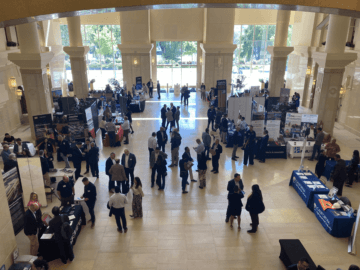 We’re moving forward on a series of procurements from track and systems to stations to construction. In May, our Chief Operating Officer Bill Casey provided our Board of Directors with a procurement overview. This presentation reflected the procurement information shared the week before at the Authority’s Small Business Fast-Track Networking Fair and Industry Update which was held on May 7 in Sacramento. For more information about upcoming procurements, check out our updated procurements page about this and other contracts, and if you are a small business that wants information about how to get work on the project, make sure your small business is registered with up-to-date information in the Authority’s ConnectHSR Vendor Registration. It’s free and will only take you a few minutes to sign up.
We’re moving forward on a series of procurements from track and systems to stations to construction. In May, our Chief Operating Officer Bill Casey provided our Board of Directors with a procurement overview. This presentation reflected the procurement information shared the week before at the Authority’s Small Business Fast-Track Networking Fair and Industry Update which was held on May 7 in Sacramento. For more information about upcoming procurements, check out our updated procurements page about this and other contracts, and if you are a small business that wants information about how to get work on the project, make sure your small business is registered with up-to-date information in the Authority’s ConnectHSR Vendor Registration. It’s free and will only take you a few minutes to sign up.
We also joined Governor Newsom and his administration in recognizing May as Small Business Month in California. Small businesses in California help power our local and state economies and provide incredibly valuable services to Californians. We continue to see robust participation by small businesses in the high-speed rail project. As of February 2024, there are 841 small businesses actively working on high-speed rail, including 291 Disadvantaged Business Enterprises (DBE) and 103 Certified California Disabled Veteran Business Enterprises (DVBE). You can read more about some of these small businesses that are contributing below in this newsletter, or you can check out the Spring issue of the Small Business Newsletter.
Getting Excited for Stations!
 We also were recently set up a series of community open houses in our four station cities in the Central Valley. The Authority alongside joint venture Foster + Partners and ARUP provided residents updates on the future high-speed rail stations being built in their communities. The meetings were held in Bakersfield, Hanford, Fresno, and Merced. Attendees got a chance to view the station concepts and provide feedback on how they wanted to see their regions represented. Check out our video where we recap these activities.
We also were recently set up a series of community open houses in our four station cities in the Central Valley. The Authority alongside joint venture Foster + Partners and ARUP provided residents updates on the future high-speed rail stations being built in their communities. The meetings were held in Bakersfield, Hanford, Fresno, and Merced. Attendees got a chance to view the station concepts and provide feedback on how they wanted to see their regions represented. Check out our video where we recap these activities.
Progress in the Central Valley
We are at the halfway point for 2024, and we have been on the move as we work to deliver the nation’s first high-speed rail project. We just recently released our Spring 2024 Progress Report highlighting continued progress being made on the high-speed rail project, including work on the Central Valley system’s largest construction site, the Hanford Viaduct. Since the start of construction, the Authority has created more than 13,000 construction jobs, a majority going to residents from the Central Valley.
Your Participation is Needed!
If you are in the transportation industry, we want to hear from you! In collaboration with WTS International, researchers affiliated with the Mineta Transportation Institute at San José State University are conducting research to better understand gender diversity and inclusion in the transportation workforce. The goal of the research is to develop recommendations that will serve as a tool to support industry leaders, policy makers, politicians, and the academic community in addressing current workforce shortage challenges. The research team is interested in learning about your experience and opinions as someone working in the transportation industry in the United States and Canada.
ALL transportation industry workers are invited to participate. This survey will take approximately 10 minutes to complete and is anonymous. Please complete the survey by July 10, 2024. For more information or questions about this study, contact the lead investigator, Jodi Godfrey, at jodis@usf.edu.
| UPDATES FROM NORTHERN CALIFORNIA |
Celebrating $3.4B Federal Commitment to CA High-Speed Rail’s Future Northern Terminus
 With a sharpie in hand, Speaker Emerita Nancy Pelosi proudly signed a wall in the trainbox several floors below the Salesforce Transit Center in downtown San Francisco, the future home of Caltrain and California High-Speed Rail.
With a sharpie in hand, Speaker Emerita Nancy Pelosi proudly signed a wall in the trainbox several floors below the Salesforce Transit Center in downtown San Francisco, the future home of Caltrain and California High-Speed Rail.
“Mass transit, but take it beyond that to high-speed rail,” Speaker Emerita Pelosi said. “This is about saving the planet. It’s about clean air. It’s about people. It’s about quality of the air. It’s about quality of the life, quality of people not having to be in their cars for long stints adding to pollution, but nonetheless getting to and from work more quickly. It’s about adding time to their lives.”
Speaker Emerita Pelosi, California State Senator Scott Wiener, and San Francisco Mayor London Breed joined partners and supporters to celebrate the federal government’s funding commitment of $3.4 billion to The Portal, a partner project led by the Transbay Joint Powers Authority (TJPA) that will bring the statewide California High-Speed Rail system into its northern terminus, extend Caltrain’s newly electrified rail system to downtown San Francisco, and connect 11 transit systems in the Bay Area at the Salesforce Transit Center.
This funding commitment along with $500 million in the Biden-Harris Administration’s FY2025 Budget Proposal, a medium-high rating and entry into the engineering phase of the Federal Transit Administration’s (FTA’s) Capital Investment Grants (CIG) program, provides the project with two-thirds of the total cost.
“From the start, TJPA’s world-class Transit Center has represented the best product of a strong, thriving public-private partnership and a model for the nation of smart, sustainable design,” Pelosi said. “Today, we celebrated major milestones at the Transit Center in our decades-long effort to bring electrified rail service into the heart of San Francisco. The Portal’s construction will make it easier for commuters to get to work, for shoppers to support our local businesses and for communities to stay connected, while reducing our city’s carbon footprint. Under the leadership of the Biden-Harris Administration, we are taking major steps toward a truly multimodal transportation network in our city.”
“This funding represents a huge leap toward the vibrant transportation system San Francisco needs to thrive in the coming years,” said California Senator Scott Wiener. “By connecting downtown San Francisco with the broader region and the state, this project will help secure a future of prosperity and progress on our climate goals. We will keep pushing to secure The Portal’s remaining funds and to complete the statewide High-Speed Rail system to ensure maximum impact. This exciting progress would be impossible without the leadership of the Biden-Harris Administration, Speaker Emerita Pelosi, Secretary Pete Buttigieg, and the Department of Transportation. I offer them my sincere thanks.”
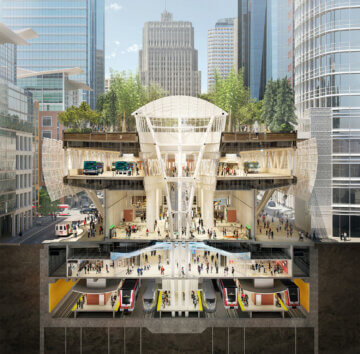 “Our work to build the future of Downtown San Francisco and transportation in the Bay Area and California got a huge boost with this major investment from our federal government,” said San Francisco Mayor London Breed. “The Portal will unlock and unite Bay Area rail connections from the South Bay to San Francisco, by bringing Caltrain all the way to the heart of our downtown, all while laying the groundwork to bring High Speed Rail to the heart of our city. I want to thank the Biden-Harris Administration, Speaker Emerita Pelosi, and the US Dept of Transportation for their leadership and vision to invest in this transformative project.”
“Our work to build the future of Downtown San Francisco and transportation in the Bay Area and California got a huge boost with this major investment from our federal government,” said San Francisco Mayor London Breed. “The Portal will unlock and unite Bay Area rail connections from the South Bay to San Francisco, by bringing Caltrain all the way to the heart of our downtown, all while laying the groundwork to bring High Speed Rail to the heart of our city. I want to thank the Biden-Harris Administration, Speaker Emerita Pelosi, and the US Dept of Transportation for their leadership and vision to invest in this transformative project.”
The Portal has completed all environmental reviews, received a medium high rating (only two of 60 CIG projects nationally scored higher), and was recommended by the Biden-Harris Administration for an advance appropriation of $500 million, one of only seven such recommendations for FY 2025. The federal funding commitment of $3.4 billion, together with existing local funds committed and budgeted for the project (including Regional Measure 3, sales tax measures Proposition K and L and tax increment funds) brings The Portal to over two-thirds funded.
The Portal’s entry to engineering is key for TJPA to continue developing design and advance the project with additional pre-award authority including pre-construction activities, and secure full local share commitments prior to FTA approval of a Full Funding Grant Agreement.
The benefits of The Portal extend far beyond San Francisco, bringing an estimated 90,000 average daily riders into the multimodal Transit Center where they can easily transfer across 11 different public transit providers serving the entire Bay Area. The Portal is one of the most efficient projects for reducing greenhouse gas emissions, vehicle-miles traveled and climate change impacts in Northern California and will create an estimated 69,000 direct, indirect, and induced jobs.
For more information about the FTA’s CIG program, visit https://www.transit.dot.gov/grant-programs/capital-investments/transbay-downtown-rail-extension-project-project-development.
HSR Celebrates Caltrain’s Past, Present, and Future
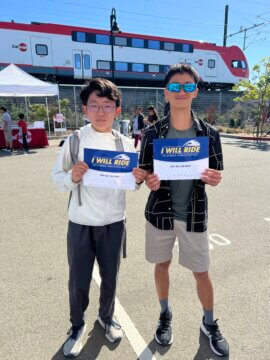 As a proud funding partner for Caltrain’s Electrification Project, the Authority celebrated the operator’s 160th anniversary along with 5,000 rail enthusiasts.
As a proud funding partner for Caltrain’s Electrification Project, the Authority celebrated the operator’s 160th anniversary along with 5,000 rail enthusiasts.
The block party in May at the San Carlos station featured public tours of the fleet’s new Stadler KISS electric train sets, which are set to begin passenger service later this year.
This year marks the 160th Anniversary of rail service between San Francisco and San Jose, the oldest continually run railroad west of the Mississippi.
It will also mark Caltrain’s move into electrified service, another historic landmark in the evolution of rail in the Bay Area. The infrastructure for the system paves the way for high-speed rail service in the region.
Assemblymember Marc Berman, who represents District 23 and serves on the Assembly Transportation Committee, says he proudly displays a golden shovel in his Palo Alto office from the project’s groundbreaking in July 2017.
“It’s impressive and really exciting to see the project since then, and our drive to improving our transit and commitment to a more sustainable future have remained consistent amongst transit agencies, all of the elected officials, both past and present, who have represented the Caltrain corridor and the community at large,” Berman said.
Authority staff spoke to more than 400 people at the event, answering questions about how Caltrain and High-Speed Rail will operate on a blended corridor along the Peninsula. The Authority invested $714 million into the Caltrain Electrification Project.
Architecture Students Design HSR through Education Lens
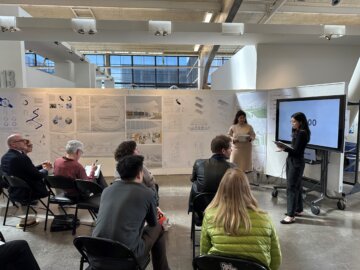 Last year, Layla Namak and Shane Chavez didn’t know much about high-speed rail. Fast forward to this summer, the two California College of the Arts (CCA) students are traveling to Japan and – you guessed it – riding the Shinkansen is on their girls’ trip itinerary.
Last year, Layla Namak and Shane Chavez didn’t know much about high-speed rail. Fast forward to this summer, the two California College of the Arts (CCA) students are traveling to Japan and – you guessed it – riding the Shinkansen is on their girls’ trip itinerary.
“I think it’s fun,” Namak says. “We have a lot more awareness of what high-speed rail is and what it can do.”
That’s because the two architecture students spent the last semester doing deep-dive research on California’s high-speed rail project. The design-research studio, taught by Associate Professor Neeraj Bhatia and aptly named “The Territorial City,” explores how high-speed rail has potential to transform and reconnect the state- in particular- the Central Valley. Infrastructure can divide or connect communities. Chavez says she discovered, “When you plan really well, infrastructure can actually have a positive social impact, not just a physical impact that gets you from point A to point B.”
In the studio, students were challenged to design their own high-speed rail urban centers focused on a certain topic.
Namak and Chavez chose education.
“Specifically, we’re thinking about how there’s a high high school dropout rate in the Central Valley and how high-speed rail can help improve graduations rates,” Namak explained.
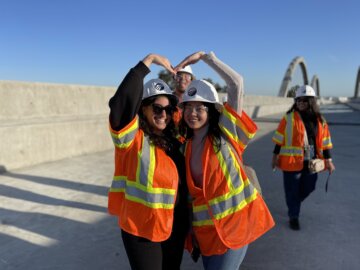 To inform their research, the Authority provided guest lectures in their San Francisco classroom and even took the students on a field visit of Central Valley construction.
To inform their research, the Authority provided guest lectures in their San Francisco classroom and even took the students on a field visit of Central Valley construction.
“Being on the platform itself is eye-opening to see the construction of the infrastructure and how it affects the landscape of California. It is so big, and it goes for miles and miles,” Chavez said.
With this in mind, Namak and Chavez tapped into the potential for high school students to explore different cities and vocations through high-speed rail.
“[In our final design,] we move students from one station to another,” Chavez said. “In high school, there’s so much to be explored.”
The students designed their system to be a distribution network of specific campuses throughout different stops along the high-speed rail route. Each one with a theme, such as arts, wood working, or a skilled trade.
“This interdisciplinary curriculum turned into an open concept space where there is a lot of cross-pollination,” Namak said, “It was exciting to see how education can be framed through an infrastructure project.”
Studying the California High-Speed Rail project was an illuminating experience for these architecture students and will influence the way they design as they pursue their architectural careers.
“Something I admire about California High-Speed Rail is the way it is being built by being very intentional about the places the network hits and its social and economic impacts on those areas. Although areas like San Francisco and Los Angeles are already major hubs and attractions for people, California can distribute those resources and that interest throughout the rest of the state–including the Central Valley, which has a deep history of resources being stripped from it,” Namak said.
The partnership with the CCA class is part of a larger effort by the Authority to connect students to the project through classroom presentations, construction tours, networking, jobs and resources. You can learn more about our student engagement efforts at hsr.ca.gov/i-will-ride.
Exploring Train Wheel Design at sciencepalooza!
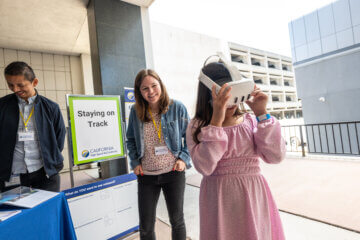
© 2024 SJSU, photo by Robert C. Bain, ALL RIGHTS RESERVED
In the heart of Silicon Valley, where technology and innovation thrive, a question arises: How will today’s youth shape the future of transportation? A study titled “Voices of Gen Z: Perspectives on STEM Education and Careers” reveals only 29 percent of students choose STEM jobs as their first career choice, despite 75 percent expressing interest in STEM (Science, Technology, Engineering, and Mathematics) fields.
In April, the Northern California Regional Outreach team took part in sciencepalooza!, a STEM event hosted by San José State University and the Synopsys Outreach Foundation that aims to encourage K through 12th grade students’ interest, nurture potential, and empower them in STEM fields. The event serves the San Jose East Side Union High School District. It offers live music, interactive tabling activities, and enthusiastic children eager to explore STEM-related content.
In a hands-on activity, the outreach team demonstrated train wheel design and centrifugal force in action. Students tested two different wheel designs on straight and curved paths. They observed the conical shape of the wheels and learned how this design helps correct the course of the train wheels on the tracks. The children were thrilled when the properly designed wheels remained on the tracks.
Students and their parents also had the opportunity to explore train interiors using immersive virtual reality. They reacted in awe at the different train cabin interiors. Bay Area resident Robert Bain said, “It’s long overdue! I’m thrilled for the high-speed rail to come in because it will open up travel options; I want an alternative!”
Leo Ortiz and his son, residents of South San Jose, expressed their admiration for the high-speed rail project in California. According to Ortiz, it “opens up a lot of work and jobs for those working on these projects. California is setting an example for other states.” Ortiz also believes the project has the potential to significantly improve travel experiences. “My travel would be vastly improved if I could jump on a train and get to Los Angeles in under 3 hours.”
Events like sciencepalooza! are essential to inspire and support young students in pursuing careers in STEM fields and the future riders of high-speed rail. As we look towards the future of transportation, it is crucial to nurture potential and empower the next generation of innovators. By providing students with opportunities to explore and engage with STEM-related content, we can ensure that they are equipped with the necessary skills to shape the future of transportation and beyond.
Meet the Architecture Firm Preserving Fresno’s Historic Train Depot
The Historic Fresno Train Depot holds great significance as it pays homage to the city’s founding in 1872 as a Central Pacific Railroad station. The original small wooden station was expanded in 1889, leading to the construction of the Historic Fresno Train Depot. With the introduction of high-speed rail tracks, the City of Fresno is set to embark on a new chapter of economic prosperity, building on the city’s origin story. The Historic Fresno Train Depot is an integral part of this revitalization, and Page & Turnbull, with their expertise in preserving historic buildings, is at the forefront of this endeavor. Their sustainable approach to conserving history while modernizing spaces involves addressing building code and environmental impact issues, while enhancing overall building efficiency.
![]()
The Daily Evening Expositor reported on July 6, 1889, that “from San Francisco to Los Angeles there is no depot that can be compared with the one to be constructed in Fresno. It will be a model building of the latest style of architecture.” Constructed of red brick and topped with a slate bellcast hip roof, the Queen Anne-style depot represents the growth of Fresno from a dry desert plain into the agri-business capital of the world in the late 1800s.
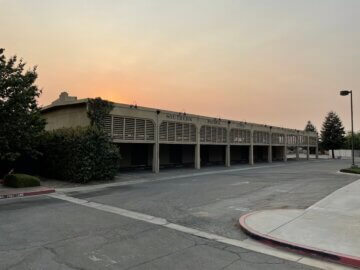 “The station is going to continue to be used and be restored to its prominence so that it can again be a vital part of the entire community,” says Peter Birkholz, AIA, LEED AP, DBIA. President of the architecture, preservation, and planning firm Page & Turnbull. He is the Principal-in-Charge for the rehabilitation project. The depot located at Tulare and H Streets is comprised of three distinct buildings: the historic passenger depot, the Freight Depot/Railway Express Agency, and the Pullman Shed, which is known to be one of the last remaining Pullman sheds in the United States.
“The station is going to continue to be used and be restored to its prominence so that it can again be a vital part of the entire community,” says Peter Birkholz, AIA, LEED AP, DBIA. President of the architecture, preservation, and planning firm Page & Turnbull. He is the Principal-in-Charge for the rehabilitation project. The depot located at Tulare and H Streets is comprised of three distinct buildings: the historic passenger depot, the Freight Depot/Railway Express Agency, and the Pullman Shed, which is known to be one of the last remaining Pullman sheds in the United States.
Birkholz says the project’s primary goal is to integrate future high-speed rail service; “maintain the historic nature of the property while updating it to allow for future uses; the historic station will provide early activation of the site.” Birkholz adds the historic buildings “will be rehabilitated to accommodate future needs and to meet current building codes for accessibility, fire and life-safety, and seismic standards.” Birkholz served in the same capacity for the relocation and rehabilitation of the award-winning Livermore Train Station.
For the past two and a half years, Birkholz led a team of six architects and designers who have worked with an even larger team who is working on the intermodal station and public areas. With sub-consultants and contractors, many of which are also small, and minority-owned businesses, they spent time performing site surveys and developing a virtual computer model of the existing building to support future uses. Proposed improvements include structural and seismic strengthening, new utilities and building systems, rehabilitation of historic features, and more to extend the performance and lifespan of the building. In addition, design documents are being prepared for permitting and construction.
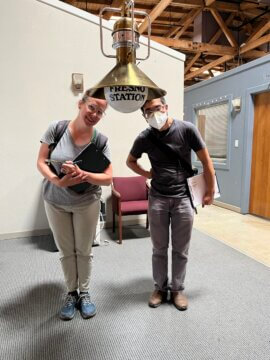 “Page & Turnbull is delighted to be a part of the design team that is developing the forward-looking High-Speed Rail intermodal station. Projects like the Historic Fresno Train Depot renovation, where a historic building and new infrastructure converge, linking the future and the past, exemplifies a key tenet of our firm’s philosophy. This project adapts a building that once served steam driven railways to become a new type of station that will efficiently and sustainably transport passengers around California. We aim to make the historic depot an iconic and economically vital part of downtown Fresno and of the high-speed rail system,” said Birkholz.
“Page & Turnbull is delighted to be a part of the design team that is developing the forward-looking High-Speed Rail intermodal station. Projects like the Historic Fresno Train Depot renovation, where a historic building and new infrastructure converge, linking the future and the past, exemplifies a key tenet of our firm’s philosophy. This project adapts a building that once served steam driven railways to become a new type of station that will efficiently and sustainably transport passengers around California. We aim to make the historic depot an iconic and economically vital part of downtown Fresno and of the high-speed rail system,” said Birkholz.
“One unique thing is that this passenger station and connected freight station combine to form a very long building (over 300 feet long), and the building with its cupolas and quirky roof lines have lots of character,” states Birkholz. Another of the project’s unique challenges is preserving the original brick and mortar structure while maintaining the structural integrity. In the performance of their work, Page & Turnbull’s team have modeled several options, such as alternative seismic options that include strengthening the brick walls with hidden concrete columns in lieu of unsightly and space reducing steel frames. The task of bringing the unreinforced brick masonry buildings up to current state seismic code is easier said than done. Brick structures of this age do not have steel reinforcing, and the roofs and floors are typically not tied together.
Utilizing state-of-the-art technology, their team performed site surveys, laser scanning and measurements that are the basis of a 3D model developed of the structure. This model is being used to prepare design documents that will be the basis of a future construction project that includes modernizing the building to current standards. Modifications such as widening doorways, eliminating steps, and even installing elevators in discreate locations that will not impact the building’s historic integrity will make the space fully accessible and available for future uses and users.
“People often think that preservation is just putting up a layer of paint, buying period furniture and making the building look old. We have a much more ambitious approach about preserving this existing building and saving its embodied carbon,” Birkholz said. Saving embodied carbon allows for less impact than building a new building in the same location. “It’s a good, sustainable approach that will maintain and highlight the story of the past and will create an inviting shell for future uses.”
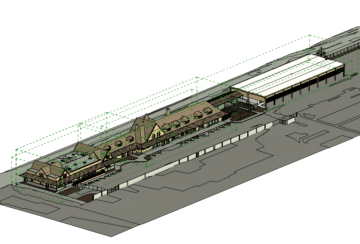 The Fresno High-Speed Rail Station, Historic Fresno Station Depot and Plaza Activation Project are critical first steps in restoring the site for passenger rail service. They will provide community benefits before high-speed rail passenger service on the Merced to Bakersfield line is initiated later this decade. In June of 2023, The Authority secured a $20 million grant from the Rebuilding American Infrastructure with Sustainability and Equity (RAISE) program which will be directly used for restoration of the historic passenger rail depot building as well as new park and plazas and tree canopies and integrate zero emissions vehicle infrastructure into historically disadvantaged communities. With a thoughtful approach to accessibility and equity, and ensuring history does not repeat, the new station design will rectify tracks from the past that were laid purposefully to segregate a then-burgeoning Chinatown.
The Fresno High-Speed Rail Station, Historic Fresno Station Depot and Plaza Activation Project are critical first steps in restoring the site for passenger rail service. They will provide community benefits before high-speed rail passenger service on the Merced to Bakersfield line is initiated later this decade. In June of 2023, The Authority secured a $20 million grant from the Rebuilding American Infrastructure with Sustainability and Equity (RAISE) program which will be directly used for restoration of the historic passenger rail depot building as well as new park and plazas and tree canopies and integrate zero emissions vehicle infrastructure into historically disadvantaged communities. With a thoughtful approach to accessibility and equity, and ensuring history does not repeat, the new station design will rectify tracks from the past that were laid purposefully to segregate a then-burgeoning Chinatown.
Birkholz says he’s “a true proponent of high-speed rail. I wish they could fully fund it and just see that it gets built out up to its ultimate destinations that both north and south. I’m thrilled just to be working on high-speed rail because I think it is a really good forward-thinking transportation solution.”
Page & Turnbull is an architecture, preservation, and cultural resource planning firm with nearly 50 professionals in four offices: San Francisco, Sacramento, San Jose, and Los Angeles. They are a State of California Certified Small Business and Women Business Enterprise. Page & Turnbull is also working on the HSR Business Case as the preservation architect for San Jose’s historic Diridon Station.
| UPDATES FROM SOUTHERN CALIFORNIA |
Authority Seeks Environmental Clearance for Key Section
 Before high-speed trains woosh through Southern California, and before a game-changing tunnel can be bored to connect Palmdale and Burbank, there is important environmental work to be done.
Before high-speed trains woosh through Southern California, and before a game-changing tunnel can be bored to connect Palmdale and Burbank, there is important environmental work to be done.
The Authority took a major step forward in that work when it released the final environmental document for the Palmdale-to-Burbank project section in late May. It is the last key environmental document needed to connect San Francisco to downtown Los Angeles. The document is on track to be presented to the Authority’s Board of Directors for consideration during a two-day board meeting June 26 and 27.
The Palmdale-to-Burbank section is undeniably one of the most complex and interesting in the entire project. At speeds up to 220 mph, this section will connect the Antelope Valley to the San Fernando Valley in a roughly 17-minute train trip – about three times as fast as traveling by car. The Palmdale to Burbank Project Section will connect two key population centers in Los Angeles County by linking future multimodal transportation hubs in Palmdale and Burbank. The section features about 30 miles of tunneling, including 28 miles through mountains.
The Final Environmental Impact Report/Environmental Impact Statement (EIR/EIS) includes analysis of all six build alternatives and the No Project Alternative. The preferred alternative is the SR14A Alternative, which runs along State Route 14 and is approximately 38 miles. It will be a grade-separated, high-speed rail-only system. Trains operating on the Preferred Alternative would be underground through the community of Acton and much of the Angeles National Forest and the San Gabriel Mountains National Monument. Tunneling through these regions minimizes impacts to communities and environmental resources in the region.
Pending Board approval, the Authority can begin preparing this segment for construction as funding becomes available. All that remains to environmentally clear the full 494-mile Phase 1 system of the project is the Los Angeles to Anaheim segment, which the Authority expects to finalize next year.
The Final EIR/EIS can be found on the Authority’s website here.
Train Talk: Outreach at Public Events in Los Angeles
 The Authority is always busy with outreach in the spring, and this year was our busiest yet in Southern California. We sponsored Girls Day for STEM students, we talked at a girls’ empowerment summit hosted by Metro Los Angeles, and we talked to transportation leaders at Infraday California.
The Authority is always busy with outreach in the spring, and this year was our busiest yet in Southern California. We sponsored Girls Day for STEM students, we talked at a girls’ empowerment summit hosted by Metro Los Angeles, and we talked to transportation leaders at Infraday California.
Our busiest days were at the Festival of Books, led by the Los Angeles Times and hosted in the middle of USC’s campus. People always want to talk about our trains, and the Festival of Books crowd was congenial and curious.
What does everyone want to know? It’s always some variation on a theme: When will the trains start running and when will riders go all the way from Los Angeles to San Francisco?
If you attended the festival, you might have heard this answer: the Authority is procuring trains, tracks and an electrification system this year for the Central Valley. Tracks and electrification will start to be installed in 2026, trains will be delivered in 2028 and testing will be in 2029 before service begins in 2030 to 2033, from Merced to Bakersfield. Getting to Los Angeles from Bakersfield is going to require tunneling through about 40 miles of mountains.
The common thread through almost every line of questioning – even the cynical ones – is people want high-speed rail. Some people want it to be done already; others want it done sooner; and some are just happy it’s being built. But very few question the need or benefits of the project.
If you’ve made it this far into the high-speed rail newsletter, you probably don’t need to be sold on the benefits. Fast travel to downtowns, airport connections, environmental benefits and community improvements are all part of the Californians are getting with high-speed rail. Face-to-face events are a highlight for staff because they provide a simple reminder: people generally support our mission and want to hear the updates.
The Festival of Books was an ideal event for the Authority. It was busy – we don’t mind crowds! And people genuinely wanted to learn more about what’s happening. We were proud to present information alongside independent authors, the LA public library, dozens of food trucks and more at the Festival of Books.
Do you have any ideas for a farmers’ market or a classroom presentation we could attend? We’re always on the lookout for opportunities. Email Southern California Outreach Director Jim Patrick at jim.patrick@hsr.ca.gov with your ideas and he’ll be quick to get back to you. In the meantime, you can count on seeing us again next year at the Festival of Books.
Terravanta Builds Social and Environmental Equity with HSR
 The high-speed rail line from Los Angeles to San Francisco is a sprawling project, spanning nearly 500 miles and with more than 13,000 jobs created so far.
The high-speed rail line from Los Angeles to San Francisco is a sprawling project, spanning nearly 500 miles and with more than 13,000 jobs created so far.
Each of those workers is making a difference for the state of California. Few are more aware of that difference than Illary Archilla, the president and CEO of Terravanta. Based in Lake Forest, Terravanta is a subcontractor for Stantec. Terravanta provides project management and utility relocation design.
Of course, it’s about engineering. But it’s also about Latina business owners who are also environmentalists.
“It just feels like a hobby in my work,” Archilla said. “We’re really passionate and we really want to make a difference. We supply support and help with management, but really the end purpose is making a difference within our communities.”
The type of difference Terravanta makes depends on the project. When working with Metro, the work involves project management of their electric vehicle maintenance program, supporting work on commissioning for the Airport Connector Project, or even bus stop enhancements involving shading, safety and lighting in disadvantaged communities. With Southern California Edison, Terravanta oversees some relocation of utilities and also management of engineering and construction of generation projects, distribution, transmission and telecom lines.
The end goal for all the projects is the same: leave the community better off than when Terravanta started on the project.
Holistic engineering isn’t often discussed, but Archilla thoughtfully designed her company based on her early job experiences. She worked in project management on infrastructure projects, while also teaching yoga in her time off. As she considered starting a company, she wanted to make sure it wasn’t just another job. The name of the company pulls from Latin, and she wanted it to have a feminine meaning. Archilla said “terra” equates to earth and the air, while “vanta” stands for vantage point. Put together, you get Terravanta.
“It really connects with the core of what we do and who I am as a human being,” Archilla said.
The connection to the high-speed rail project is easy to understand. Yes, there are critical environmental and social benefits; it’s also just a really cool project.
“I’m a mechanical engineer, so anything that has wheels and moves is exciting,” Archilla said with a laugh.
But there’s more to it than that. Archilla gets excited talking about the huge economic benefits coming to the Central Valley, but also loves that people will be able to visit the giant sequoias in the Sierra Nevada mountains. The train is much more environmentally friendly than flying from LA to San Francisco and will run on renewable energy. But most of all, Archilla said, the first-in-the nation project will show the nation and the world what California is capable of.
“I think California always leads in different aspects of the world, and I think this just reenforces California’s position and shows what can be done,” she said. “The benefits are there, not only social and environmental justice, but financially as well.”
In a sense, the project is already making a big impact. Workers are getting training and jobs. Construction vehicles are cleaner than ever before. And small businesses like Terravanta – on of more than 800 in the Authority’s Small Business program – are making a big difference every day.
Authority Moves Forward on LA-to-Anaheim Section
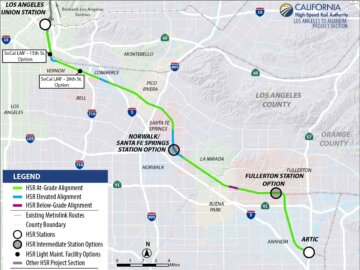 The Authority is pleased to report the Los Angeles to Anaheim (LA-A) Project Section reached a new milestone, moving closer to connecting LA/Anaheim to the Central Valley and San Francisco with a one-seat, high-speed train ride.
The Authority is pleased to report the Los Angeles to Anaheim (LA-A) Project Section reached a new milestone, moving closer to connecting LA/Anaheim to the Central Valley and San Francisco with a one-seat, high-speed train ride.
On Thursday, May 16, the Authority’s Board of Directors adopted the Shared Passenger Track Alternative A with the Southern California Light Maintenance Facility at 26th Street as the Preferred Alternative for the LA-A Project Section. Both the new Preferred Alternative and the Shared Passenger Track Alternative B with the Light Maintenance Facility at 15th Street will be carried forward for further study in the draft environmental documents. Click here to view the presentation.
The Shared Passenger Track Alternative was developed as part of the Supplemental Alternative Analysis (SAA) released in November 2023. The Shared Passenger Track Alternative generally resembles the 2018 HSR Project Alternative but include some updates, including: a potential reduction in high-speed train operating frequency, removal of the Colton Intermodal Facility, a modified approach to intermediate stations between Los Angeles Union Station and Anaheim (ARTIC) Station, a revised approach to grade crossings in Anaheim, and proposing staging tracks in the High Desert. The Authority held a series of outreach activities to share the SAA with the public and receive feedback.
The Authority utilized technical studies and stakeholder feedback to prepare a Preliminary Impacts Analysis to recommend the Shared Passenger Track Alternative A as the option that best aligns with the statewide HSR program aiming to build a high-speed rail system contributing to economic development, a cleaner environment, and job creation; all while investing in regional and local rail lines to meet the state’s 21st-century transportation needs.
Upcoming Events
Here are upcoming events that you won’t want to miss!
North Beach Festival
June 15 – 16, 2024
The North Beach Festival is a vibrant and historic neighborhood celebration featuring over 150 local makers, artists, merchants, and organizations, as well as delicious food, beer and wine gardens, street painting, live music, and family-friendly activities. Stop by and talk with us about high-speed rail! Click here for more information.
Summer Fun Nights at the California State Railroad Museum
June 27 – 28, 2024
6:00 p.m. – 8:00 p.m.
Authority staff will be at the California State Railroad Museum in Sacramento for a fun and educational two nights for families.
SF Pride at Caltrain 4th & King
June 30
Time: TBA
Authority staff will be at the corner of 4th and King streets – San Francisco Station – to talk about the project at one of the largest Pride celebrations in the world.
California State Fair
July 12 – July 28, 2024
Get a sneak peak of our future high-speed rail trainset interiors and stations at the California State Fair, the annual state fair for the state of California. The fair is held at Cal Expo in Sacramento, California. Click here for more information.
Pobladores Night Market
July 18
5:30 p.m. – 9:00 p.m.
Authority staff will be at the Pobladores Night Market in Downtown San Jose. Stop by to enjoy live music, food trucks, and talk with us about high-speed rail. Click here for more information.
Other Events
Here are other events that we aren’t staffing, but may be fun to attend!
Redwood Valley Train
redwood-valley-railway.business.site
At the southern end of Tilden Park in Berkeley, you’ll find the Redwood Valley Railway, showcasing intricate miniature live steam engines. Visitors can enjoy 12-minute train rides that wind through the railway’s namesake redwood forest. It’s truly a magical experience!
Howarth Park Santa Rosa
www.howarthpark.com
In Santa Rosa, you’ll find a charming park showcasing a small-scale railroad complete with tunnels and bridges. Additionally, the park offers playgrounds, a carousel, hiking trails, a lake.
Roaring Camp
www.roaringcamp.com
Located in the Santa Cruz Mountains, this steam-engine train offers rides through the redwood forest and to the Santa Cruz Beach Boardwalk. With special events over the Summer, there’s fun for everyone!
Niles Canyon
www.ncry.org
Ride historic locomotives through Niles Canyon, near Fremont. Steam diesel locomotives are an experience to enjoy from the Niles station on select Saturday and Sundays.
Quarterly Newsletter Archive
- Winter 2024 All Aboard Newsletter
- Fall 2023 All Aboard Newsletter
- Summer 2023 All Aboard Newsletter
- Spring 2023 All Aboard Newsletter
- Winter 2023 Quarterly Newsletter
- Fall 2022 Quarterly Newsletter
- Summer 2022 Quarterly Newsletter
- Spring 2022 Quarterly Newsletter
- Winter 2022 Quarterly Newsletter
- Fall 2021 Quarterly Newsletter
- Summer 2021 Quarterly Newsletter
- Regional Newsletter - May 2021
- Regional Newsletter - February 2021
- Regional Newsletter - November 2020
- Regional Newsletter - August 2020
- Regional Newsletter - June 2020
- Regional Newsletter - February 2020
- Regional Newsletter - November 2019
- Regional Newsletter - August 2019
The California High-Speed Rail Authority makes every effort to ensure the website and its contents meet mandated ADA requirements as per the California State mandated Web Content Accessibility Guidelines 2.0 Level AA standard. If you are looking for a particular document not located on the California High-Speed Rail Authority website, you may make a request for the document under the Public Records Act through the Public Records Act page. If you have any questions about the website or its contents, please contact the Authority at info@hsr.ca.gov.



